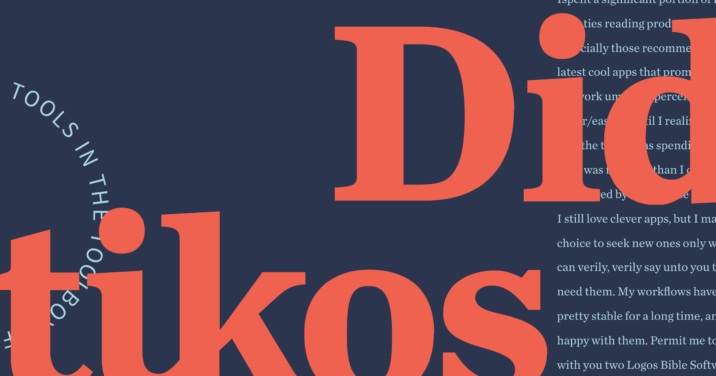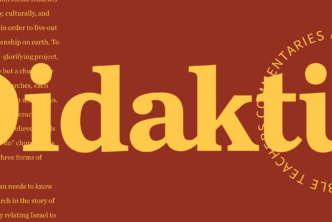Graded Implementation for Using Digital Tools in Original-Language Courses
The speed with which digital technology has swept through our society has certainly made an impact on original-language learning. Whereas it was previously unthinkable to attend a masters-level class with a laptop full of digital parsing tools, students can now enter the classroom armed with massive libraries of original-language resources and search engines.
Unfortunately, due to this amazing technology, many schools have moved away from rigorous language training in Greek and Hebrew. In exchange, many institutions have implemented language training programs that focus exclusively on learning how to use digital programs like Logos or Accordance.
When I began seminary, digital resources were forbidden, even for pre-class preparation. Now the pendulum has swung in many institutions, such that digital resources alone comprise the entirety of the language curriculum. But could there be a middle road? Is there room for both rigorous language training and best practices in using digital tools?1 Could this middle road make language training joyful and meaningful rather than just another checkbox in an academic degree program? I would argue the answer is “yes.”
As with any “middle-of-the-road” model, each side must compromise to some degree. For those who would argue that digital tools stifle genuine language learning, the middle ground must admit that digital tools can be helpful in specific instances. For those who land on the side of using digital tools exclusively, there must be a realization that rigorous language learning is necessary for students to assess the most potent data they encounter in digital tools.
At the end of the day, there is room within rigorous language training for digital tools and there is also value in learning the biblical languages well so that the digital tools become even more beneficial.
Graded implementation
As the subtitle of this article suggests, a proposed model for this middle ground is “graded implementation.” At no point should digital tools supersede rigorous language training. At the same time, implementing certain digital tools at strategic points along the way can increase a student’s motivation to learn.
I would argue that, as students implement strategic features of digital tools at the right time, those tools increase their instrumental motivation such that they want to keep learning.2 The ability to conduct a strategic word search opens a world of exegetical and interpretive rabbit holes, inspiring new and joyful questions about the text.
Language learning, at that point, moves from a series of charts and parsing rules to a meaningful interaction with the text of Scripture. Graded implementation is not just a model to gradually incorporate computer skills. Rather it is assessing what features within digital tools will lead to increased joy and motivation for students to continue the language-learning journey.3
My argument is this: using graded implementation of digital tools has the capacity through computer-assisted language learning (CALL)4 to increase instrumental motivation in students, such that digital tools enhance rigorous language learning rather than stifle it.
With the theoretical argument now on the table, what are some practical ways to implement this graded approach? First, we must be creative with how to implement digital tools very early. Even as students begin learning vocabulary, teaching them how to use digital lexica and computer-assisted word searches can aid students’ ability to retain vocabulary, since they can see how a certain word may be used across varying contexts.
This quick word search would help internalize the word, moving it from a set of characters on a vocab card to a meaningful word for future exegetical study. A student could see that דֶ סֶ֫ ח (ḥesed) is a far richer word than just “steadfast love,” and this discovery will likely lead to a greater desire to journey deeper down the rabbit hole.
Digital tools
Second, we should use the digital tools for areas of language study that can be difficult for students to ascertain. I learned Hebrew using a morphology-heavy approach. We learned, for instance, that “originally open pro-pretonic syllables will reduce an original short vowel to a vocal shewa.”5 This can lead to a very dry experience, trying to force as many rules into short-term memory as possible. However, what if the professor taught the students how to search for a series of masculine plural nouns that have a resulting vocal shewa in the first consonant? (For example: דָ בָ ר⟵ּדְ בָ רִ ים; davar ⟶ devarim.)
After this search, the students can see the pattern by which a vowel on their vocab card becomes a shewa when the accent shifts. Whether they become comfortable with the rule or not, they are comfortable seeing that vowel change when reading the Hebrew Bible. This comfort, through seeing many examples in a digital search, aids students’ motivation to keep going. The complex rule becomes familiar and is no longer a stumbling block when a student reads.
Another area of Hebrew language learning that can be difficult for students is weak verbs. Certainly, this is not a formal “exegetical skill,” but students must be able to recognize verbal forms to do good exegesis. Using the Hebrew Grammatical Constructions dataset in Logos, students can search for all the weak verbs of a certain type (I-Guttural; III-ה; etc.) and begin to observe and analyze the patterns of weak verb morphology.
While the morphological changes are indeed still tricky, students can begin to see the most common patterns for a particular type of weak verb so that they are no longer intimidating.
In fact, with enough exposure, it’s possible that weak verb morphology becomes normal. Yes, these forms differ from the paradigm, but students will see far more consistency in weak verb morphology when they can isolate a particular type of weak verb and observe the morphological changes. Now, in addition to remembering that a Hiphil I-ו verb coalesces the original הַ וְ ⟵ הוֹ, the students also begin to say, “Oh yeah … of course, Hiphil I-ו verbs coalesce the vav to a ḥolem-vav.”
Exegetical research
Finally, at the upper levels of graded implementation, the student is ready to do in-depth exegetical research. This might include searching for all the occurrences of an infinitive absolute to see how they function grammatically and what that means for interpretation. Perhaps the student encounters a difficult syntactical constituent in a verse but learns to generate a search string to find that same construction elsewhere, shedding light on the verse at hand.
With enough experience, digital tools can count and find these results within seconds to pique the students’ interest and understanding, all the while increasing their motivation to keep going. Even so, if a student has not had robust training in the language, then analyzing these results will prove unfruitful. Graded implementation must include the right implementation, at the right time, of both digital tools and robust language instruction. Surprisingly, they seem to work hand-in-hand.
With all of the approaches to language learning already in existence, it’s difficult to propose another novel model. In fact, this proposal is not novel at all. I’m simply proposing that Hebrew and Greek professors think creatively about the right combination of digital tools at the right time, so that those tools enhance robust language learning.
Students will be motivated to keep learning by seeing the exegetical payoff of their time and effort. As a result, I believe they will desire to keep up with original-language learning long after graduation.
I tell my students that when we get into the text of Scripture, “that’s where the magic happens.” By “magic,” I mean that’s where you begin to see that your hard work studying is worth it because you experience the ability to understand, interpret, and enjoy the Bible in the original language. If digital tools can enhance that joy by empowering students to dig deeper into the Hebrew and Greek text, why would we not implement the right ones at the right time?

***
This article was originally published in the October 2022 issue of Didaktikos. Slight adjustments, such as title and subheadings, may be the addition of an editor.
Related articles
- How to Retain (and Improve) Greek and Hebrew after Seminary
- Biblical Language Principles That Will Improve Your Bible Study
- Seminary and Church: Allies or Enemies?
Related resources
Hebrew for Life: Strategies for Learning, Retaining, and Reviving Biblical Hebrew
Regular price: $22.99
- “Digital tools” here refers specifically to programs like Logos Bible Software or Accordance Bible Software. The excellent work of Biblingo and Aleph with Beth in a living-language approach falls outside the focus of this article (though I would encourage all to look at their work, as well).
- A distinction must be made between integrative motivation and instrumental motivation. Integrative motivation is when the student desires language learning in order to “integrate” in the society of the target language. Instrumental motivation involves the desire to accomplish an intended goal or outcome (George Yule, The Study of Language, 7th ed. [Cambridge: Cambridge University Press, 2020], 225). While computers certainly assist in integrative motivation, that would be more limited to communicative (living-language) approaches. Here, we are talking specifically about Hebrew language learning in an English-speaking environment.
- Studies have shown that the “degree of motivation is better predictor of future learning success than is the type of motivation” (William O’Grady et al., Contemporary Linguistics: An Introduction, 5th ed. [Boston: Bedford/St. Martin’s, 2017], 423). Even if it is instrumental motivation to accomplish a certain goal, if implementing digital tools will help aid that motivation for a lifetime of learning the original languages, then it is worth the effort to figure out how to implement them responsibly.
- Computer-assisted language learning (CALL) to aid second-language learning (SLL) is distinguished here from using computers in second-language acquisition (SLA). The comments here focus on the use of digital tools for finding and counting results of a search string that the student can then observe and analyze. There are many excellent computer-based programs for second-language acquisition, but that is outside the focus on this essay.
- Russell Fuller and Kyoungwon Choi, Invitation to Biblical Hebrew: A Beginning Grammar (Grand Rapids: Kregel, 2006).





